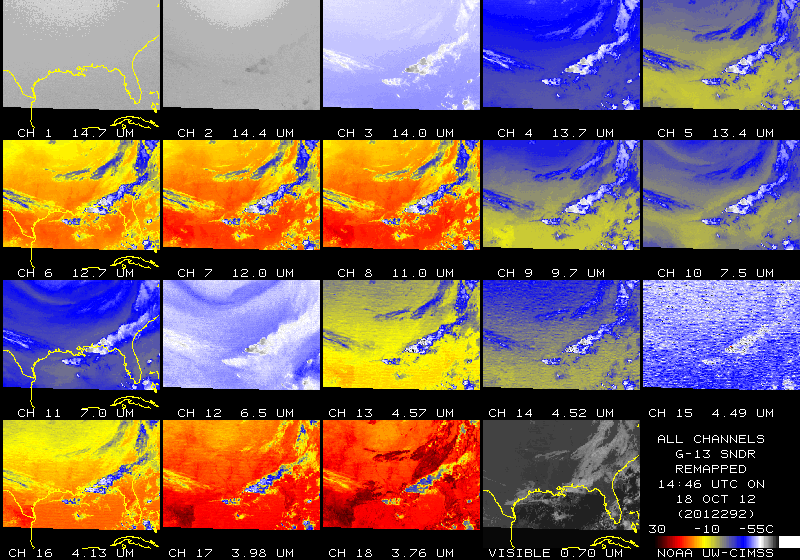 |
ASPB and CIMSS Weekly Report
[ Archive ] |
 |
ASPB AND CIMSS WEEKLY HIGHLIGHTS FOR THE WEEK ENDING OCTOBER 20, 2012
IN THE PRESS:
ITEMS FOR THE ADMINISTRATOR:
ITEMS FOR THE ASSISTANT ADMINISTRATOR:
ITEMS FOR THE OFFICE DIRECTOR, STAR:
CIMSS Graduate Students Win Presentation Awards: On
19 October 2012, the National Weather Association (NWA) officially
announced the best student presentations that were given during the NWA
annual meeting in Madison, Wisconsin. Three graduate students
affiliated with the Cooperative Institute for Meteorological Satellite
Studies (CIMSS) were recognized for outstanding presentations. William
Line won first place in the best graduate student poster presentation
category for his poster titled "Future Improvements to Very-short-range
Forecasts of the Pre-convective Environment Using Operational
Geostationary Satellite Observations". In the same category, Agnes Lim
won second place for her poster titled "Assimilation of AIRS Radiances
using GSI/WRF for Short Term Regional Forecasts". For overall best
graduate student oral presentation, Jordan Gerth was recognized with his
talk titled "Linear Optimization as a Solution to Improve the Sky Cover
Guess, Forecast". Approximately three dozen students from around the
country presented at this year's meeting. There were around 400
meteorologists in attendance. (J. Gerth, CIMSS, 608-263-4942)
ITEMS FOR THE DIVISION CHIEF, CoRP:
Advanced Dvorak Technique Delivered: The latest version of the Advanced Dvorak Technique (ADT), version 8.1.4, was delivered to NOAA/Satellite Analysis Branch (SAB). This version represents a major upgrade in the algorithm's functionality, allowing the direct utilization of Passive Microwave (PMW) imagery, and corresponding PMW image analysis, to be performed within the code. Using the PMW imagery, and the information derived from its use, will improve the accuracy of the ADT and provide the tropical cyclone forecasters at SAB with an improved tool to estimate tropical cyclone intensity using satellite imagery. Scientists at the Cooperative Institute for Meteorological Satellite Studies (CIMSS) and forecasters at NOAA/SAB have formed a tremendously beneficial collaboration since the mid 1990's that has resulted in improvements to the code and the implementation of the ADT at SAB since the mid-1990s. (T. Olander, CIMSS, 608-265-8005, C. Velden, CIMSS, 608-262-9168)
GOES-13 Imager and Sounder return to Service: The Geostationary Operational Environmental Satellite (GOES)-13 Imager and Sounder returned to operational service on October 18, 2012. Cooperative Institute for Meteorological Satellite Studies (CIMSS) / ASPB monitored the test GOES-13 sounder data and select derived products after the sounder instrument outgas. More information can be found on the CIMSS satellite blog at http://cimss.ssec.wisc.edu/goes/blog/archives/11582. (J. Nelson, CIMSS, 608-263-6013, S. Lindstrom SSEC, 608-263-4425, T. Schmit, E/RA2, 608-263-0291, tim.j.schmit@noaa.gov).
 (Click image to enlarge)
(Click image to enlarge)
Figure caption: GOES-13 Sounder multi-band image from October 18, 2012. While some instrument noise is still noticeable in the shortwave bands (13-18), the noise is much reduced compared to before the instrument outgas (not shown).
CIMSS Delivers GSICS Results for GOES-14: During August and September of 2012 Geostationary Operational Environmental Satellite (GOES)-14 was utilized in a primarily experimental mode gathering 1-minute imagery, occasionally mirroring the operational GOES-East schedule, and providing Full Disk imager scans nominally every 3 hours. On September 23, 2012 GOES-13 experienced technical problems which culminated in GOES-14 becoming the operational GOES-East for approximately four weeks. During part of this time NESDIS personnel and computers were being moved to their new building and they were unable to monitor GOES-14 calibration accuracy. Researchers at the Cooperative Institute for Meteorological Satellite Studies (CIMSS) ran the NESDIS Global Space-based Inter-Calibration System (GSICS) software and delivered the results to NESDIS scientists for the period of approximately 15 August 2012 to 30 September 2012 so that NESDIS and NOAA could validate GOES-14 calibration accuracy were it to become the operational GOES-East. (M. Gunshor, CIMSS, 608-263-1146, S. Lindstrom, CIMSS, T. Schmit, E/RA2, 608-263-0291)
CIMSS VISIT Activities: S. Lindstrom led the Virtual Institute for Satellite Integration Training (VISIT) lesson "Geostationary Operational Environmental Satellite (GOES)-R Fog/low stratus (FLS) products" on October 17 and 18, with staff from the National Weather Service forecast offices at Nashville, Tennessee, Hanford, California, Philadelphia, Pennsylvania, and Tampa, Florida participating in the training. S. Lindstrom and S. Bachmeier also participated in two "VISIT Satellite Chat" sessions (http://rammb.cira.colostate.edu/training/visit/satellite_chat/) that were held on October 17. In addition, the Cooperative Institute for Meteorological Satellite Studies (CIMSS) Satellite Blog (http://cimss.ssec.wisc.edu/goes/blog/) was updated with posts addressing the return of GOES-13 as the operational GOES-East satellite, a major blowing dust event that affected parts of the central US, and Tropical Storm Rafael in the Atlantic Ocean. (S. Lindstrom, CIMSS, 263-4425, S. Bachmeier, CIMSS, 608-263-3958)
 (Click image to enlarge)
(Click image to enlarge)
Figure caption: Aqua MODIS true color Red/Green/Blue (RGB) image showing a large plume of blowing dust across parts of Nebraska, Kansas, and Oklahoma on October 18, 2012.
VISITORS:
Scientist from EUMETSAT Visits CIMSS: Dr.
Regis Borde, a scientist from the European Organisation for the Exploitation of Meteorological Satellites (EUMETSAT), visited the Cooperative Institute for Meteorological Satellite Studies (CIMSS) to discuss topics associated with the
production of atmospheric motion vectors (AMVs). Researchers from
EUMETSAT and CIMSS have had a long collaboration of exchanging ideas and
algorithms toward advancing the quality of AMVs. Dr. Borde discussed
the first results of a new tracking method being developed at EUMETSAT,
while also learning about AMV height assignment issues being explored at
CIMSS. (C. Velden, CIMSS, 608-262-9168, S. Wanzong, CIMSS)
NEXT WEEK:
LOOKING AHEAD:




 (Click image to enlarge)
(Click image to enlarge)